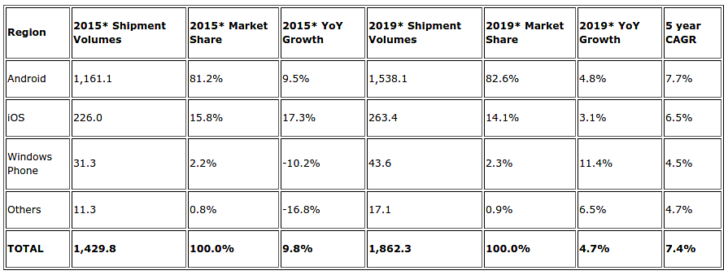Market research firm IDC is forecasting a single-digit growth for worldwide smartphone market this year, something which would happen for the firm time. The firm is predicting a growth of 9.8% in 2015 to a total of 1.43 billion units.
As for the reason, IDC mentions slowdown in shipments in Asia/Pacific (excluding Japan), Latin America, and Western Europe. It also notes that the economic slowdown in China – the largest smartphone market by shipments – has affected the overall market growth.
 Image credit: Lam Yik Fei/Getty Images
Image credit: Lam Yik Fei/Getty Images
“With the smartphone market finally slowing to single-digit growth, maintaining momentum will depend on several factors,” said Ryan Reith , Program Director with IDC’s Worldwide Quarterly Mobile Phone Tracker. “The main driver has been and will continue to be the success of low-cost smartphones in emerging markets.”
“This, in turn, will depend on capturing value-oriented first-time smartphone buyers as well as replacement buyers. We believe that, in a number of high-growth markets, replacement cycles will be less than the typical two-year rate, mainly because the components that comprise a sub-$100 smartphone simply do not have the ability to survive two years. Offering products that appeal to both types of buyers at a suitable price point will be crucial to maintaining growth and vendor success.”
As for areas of growth, IDC says the Middle East & Africa (MEA) region will surpass “hot markets” like India and Indonesia this year with an year-on-year shipment growth of 50%.
The research firm is predicting the worldwide smartphone market growth to come down to just 4.7% by the year 2019. Here’s the detailed forecast data IDC shared for the 2015-2019 period:
 While Google’s Android will continue dominating the smartphone OS market, Apple is expected to stay at the number two spot with a market share of around 14-15%. However, IDC isn’t expecting Windows Phone share to grow over the next four years, and the firm is even forecasting a year-over-year decline of -10.2% for the OS in 2015, saying it’s largely due to “lack of OEM partner support.”
While Google’s Android will continue dominating the smartphone OS market, Apple is expected to stay at the number two spot with a market share of around 14-15%. However, IDC isn’t expecting Windows Phone share to grow over the next four years, and the firm is even forecasting a year-over-year decline of -10.2% for the OS in 2015, saying it’s largely due to “lack of OEM partner support.”
[“source-gsmarena”]










